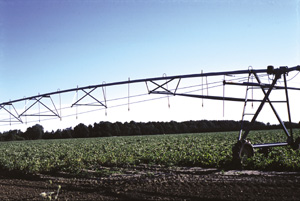
Features
Agronomy
Diseases
Anthracnose in corn not a priority
Wet seasons tend to be worse.
November 12, 2007 By Top Crop Manager
 Of all the diseases and management practices that can be controlled, concerns
Of all the diseases and management practices that can be controlled, concerns
about anthracnose in corn are not likely to be front and centre. Despite 2004
being a year when it could – and by some accounts should – have been
a problem, growers in Ontario fared reasonably well against the disease. Typically,
anthracnose is a problem during cool, wet summers and 2004 was perfect for a
heavier infestation. But according to Dave Townsend, field crops agronomist
for Syngenta Seeds Canada, although it attracted some attention at meetings
in late spring, anthracnose in corn never really posed a significant threat
with the approach of harvest. "We were worried about conditions similar
to when anthracnose came in 2000 with the heavy rust year," says Townsend,
who covers western Ontario. "We were open for infection but we didn't have
the rust levels because the dry weather in August and September slowed the disease
progression."
Townsend agrees that like some of the emerging viruses in soybeans, growers
need to be aware of the cumulative effect of disease conditions. Although anthracnose
in corn is not a new disease, its inclusion in a host of scenarios that can
weaken or devastate corn is the key to managing it and others. "The way
I explain it at meetings is that it's the cold that wears you down and gives
you pneumonia, but it's not the cold that kills, it's the pneumonia," explains
Townsend. "It's the same with the corn plant; it's the rust and the leaf
diseases and the wet roots and cold nights that stress the plant. But that is
not what kills it, it's the anthracnose, stalk rot and crown rot organisms that
finally come in and put the corn down for the count."
While there are many other diseases that can affect the crop, like charcoal
rot and in some cases, stalk and crown rots, the weather again favoured growers.
"Dry and warm weather conditions in late September slowed many of the late-season
infections, as well," says Townsend. "The open fall through October
without a frost allowed the plant to maintain its plant health, so standability
issues were reduced in 2004, compared to 2003."
Bigger issues to watch
For Greg Stewart, there are far more serious conditions worth a grower's attention
than anthracnose in corn. He agrees that it has been getting more attention
in recent years, particularly 2004 and 2000. But he also cautions against the
tendency towards hyping a situation, even if it comes with a so-called 'win-win'
outcome in raising awareness. "If you're right, people say, 'They did warn
there was more anthracnose, and sure enough, our corn's flat!' and if you're
wrong, people say, 'Great, they were wrong, our stalks are all standing wonderfully
well'," says Stewart. "Either way, we talked a lot about how much
anthracnose there was in September."
The choice of planting a hybrid with an excellent disease resistance package
comes with some cost. If the weather is warm and dry, and anthracnose is not
an issue, a grower can give-up some yield in exchange for disease resistance
without sufficient cause. "In field corn, it's never shown to be cost effective
to do anything about it," says Stewart, especially when the cash price
is below the cost of production. "There are about 19 other current management
decisions that could have more impact than worrying about anthracnose."
In fact, he adds, one of the subcommittees of the Field Crops Research and
Services Committee recently reported that there are 22 priorities relating to
field crop insects and diseases. "And anthracnose in corn did make the
list, but it was 20th or 21st," notes Stewart. He realizes monitoring and
tracking disease pressures and changes is an important task, and that growers
want to avoid being blind-sided by a disease that largely goes unnoticed. "I'm
not saying it isn't good to keep track of it, I just wouldn't want to be accused
of having farmers get too excited about anthracnose, when I think there are
other more bottom-line impact issues."